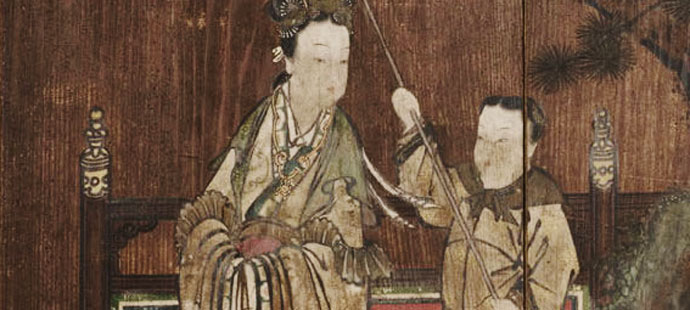
Artist/maker unknown, Japan
Edo Period (1615-1868)
Medium: Ink and color on cedar wood (sugito), sliding doors
Dimensions: 63 3/4 inches × 7 feet 2 1/2 inches (161.9 × 219.7 cm)
Xiwangmu, the Queen Mother of the West, is a Chinese Daoist deity who was said to reside in the legendary Kunlun Mountains and to cultivate the elixir of immortality. Called Seiobo in Japanese, the goddess is shown here accompanied by a servant with a fan, while another attendant holds the peaches of immortality.
Credit Line: Purchased with the Fiske Kimball Fund and the Marie Kimball Fund, 1966
Sabbatical leave for faculty often yields impressive research. For Dr. Georgia Arbuckle-Keil, Professor of Chemistry, her 2017-2018 sabbatical proved no different. The year was dedicated to an art conservation project with Beth Price, Senior Scientist, and Peggy Olley, Conservator, of the Philadelphia Museum of Art (PMA). Dr. Arbuckle-Keil served as an advisor on Ms. Price’s graduate liberal studies capstone project years ago, and the two have wanted to collaborate before; their hope came to fruition late last year with a project to evaluate polymer coatings previously applied to Japanese sliding cedar doors, known as sugito, with the hope to stabilize the painted designs on the doors.
The PMA has twenty sugito in their collection, purchased with the Fiske Kimball Fund and the Marie Kimball Fund in 1966. The doors are believed to be from the Edo Period (1615-1868). Dr. Arbuckle-Keil explains that a polymer coating was applied to the sugito in the 1960s as a way to preserve and consolidate the painted areas on the doors. However, over time it was discovered that this soluble nylon actually becomes insoluble, ages poorly, and is a magnet for dust and dirt. It is feared that removing the coating would cause damage to the doors, but the conservation team at PMA must find a method to stabilize the designs. Dr. Arbuckle-Keil has spent the past year obtaining samples of the coating and comparing it with soluble nylon powders used by other art museums, in order to characterize the coating and to understand its chemistry. This foundational knowledge will help the team know how best to proceed in conserving the design on the doors. This research will be presented under the title “Polymers in Cultural Heritage” at the National Meeting of the American Chemical Society in August 2018.
Written By Julie Roncinske

